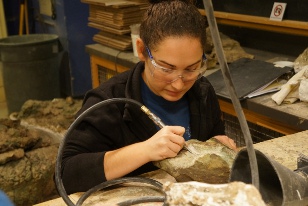New Mystery Dinosaur Fossils
PHILADELPHIA,
January 31, 2013

There’s a new mystery dinosaur at the Academy of Natural Sciences of Drexel University. This winter, mounds of rock containing fossils from a creature that roamed the Midwest millions of years ago were set up in the museum’s Fossil Prep Lab, where technicians are working in public view to remove the beast’s remains from the rock. Scientists have yet to determine what species it is, but they have tantalizing clues.
Jason Poole, who oversees the lab and has participated in dinosaur digs around the world, says the fossils were unearthed in Wyoming in 2011 by a team from the New Jersey State Museum in Trenton. Scientists already know the fossils belong to a 25-foot-long, duck-billed, plant-eating dinosaur that lived 67 to 70 million years ago. It’s of the hadrosaur family, the same family as the famous Hadrosaurus foulkii, the world’s first nearly complete dinosaur, which the Academy displayed in 1868 as the world’s first mounted dinosaur.
But scientists won’t know what species of hadrosaur the mystery dinosaur is until they can fully see and examine the fossils. Even though they have found only a small portion of the dinosaur, scientists are confident they will be able to identify it, especially since they have parts of the skull, which often is not recovered.
“From neck to tail, all hadrosaurids look alike,” Poole says. “But we have a good bit of the skull, which makes it a lot easier to identify the species. We doubt it will be a new species unknown to science.”
The slow but fascinating process of carefully removing the fossils from the rock will take place in full public view during regular museum hours, so visitors can watch, take photographs and ask questions of the staff. The progress will unfold week to week, month to month as pieces of a jawbone, rows of teeth, and an upper arm are revealed bit by bit. The dinosaur should be fully exposed by the end of the summer.
“People should come see these bones being prepared because this is a rare instance where you can actually see science happening,” said Jason Schein, assistant curator of natural history at the New Jersey State Museum, who led the excavation. “It’s amazing to think that those bones have been encased in that rock for tens of millions of years, were discovered by scientists walking around the desert in Wyoming, dug up, and brought a few thousand miles to Philadelphia. It’s all a pretty remarkable journey.”
Schein said the bones are in good shape and show interesting features, such as muscle attachment scars.
“Every time we find a dinosaur, no matter how common the species may be, it increases our knowledge of the species and its environment. Paleontology is one science with very few data points, so every one of them is important,” Schein said.
Schein’s team, Poole and Philadelphia public high school students in the Academy’s Women In Natural Sciences program plan to return to the site this summer to look for more dinosaur fossils.
Meanwhile, a fully mounted cast of Hadrosaurus foulkii, discovered in Haddonfield, N.J., in 1858, is on display through June 9 in the Academy’s Art of Science Gallery exhibit Drawn To Dinosaurs: Hadrosaurus foulkii. For more information, visit ansp.org.
Media Contact